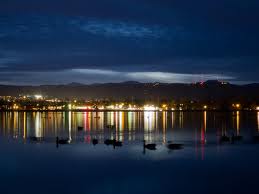by Roger Carey
 My wife and I bought on the lake with plans to get away from the lights, noise and congestion we came from. Why do people move to the lake then turn it into the place they came from?
My wife and I bought on the lake with plans to get away from the lights, noise and congestion we came from. Why do people move to the lake then turn it into the place they came from?
The negative effects of light pollution on human activity are numerous. From an economic point of view, wasted light is wasted money and the switch to more conscientious lighting can put not just the night sky overhead in the black but also balance sheets. The International Dark-Sky Association figures about a third of outdoor lighting is wasted because of poorly designed and inefficient fixtures. It estimates that in the U.S. alone, the annual price tag for misdirected light is $10 billion. (We know of a person who just remodeled their house and now has over 15 recessed lights on the outside of the house alone. Why would you ever need over 15 outside lights?)
In terms of public safety and crime, experts say that more light is not necessarily better. Fixtures that reduce light pollution can actually make lighting safer, by reducing what’s known as disability glare. This type of glare occurs when bright light scatters within the eye making it harder to detect contrast-and harder to see people lurking in the shadows. It also allows the criminals to better see what they are doing. Motion-activated lights can help reduce both light pollution and criminal activity. They’re off when no one’s around, reducing wasted light and energy, but turn on when someone moves past, alerting others to the activity. (We have a friend whose house was broken into while he was asleep in bed and his wife was asleep on the couch with the TV and lights on. Fortunately, he woke up while the criminal was there and after a major scuffle with the crook and him yelling to his wife to get the gun, the crook left. Our friend had a few cuts and bruises.)
Wildlife and plants are also affected. For example, nighttime lighting can confuse animals that migrate (like moths and migratory birds), can modify predator-prey relationships and can even alter competitiveness within the same species. In the case of moths, for example, it was discovered that numerous flowering plants declined in numbers when the flight paths of pollinating moth species were affected by light pollution.
As for the people who light up their beaches at night, it is even possible for entire ecosystems to be affected. In lakes, for example, zooplankton may stop feeding on algae if nighttime lighting is too strong. The result is excessive algae growth that eventually decomposes and causes an increase in bacterial activity. This leads to oxygen depletion in the lake, and many species of invertebrates and fish then die by asphyxiation.
Please take care of your lake; it will last longer, if not for you, do it for your kids, grand kids, and all the wildlife that lives because of your lake. For more information, join your lake association or join a state wide lake association, study, and educate yourself.
Most of this article is compiled from several articles on the internet.
